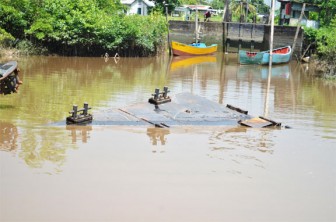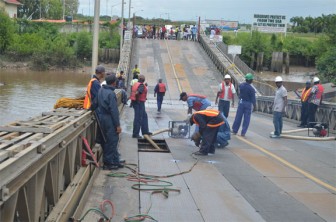A small section of the Demerara Harbour Bridge sank yesterday morning, forcing its closure for emergency works and limiting travel between regions Three and Four, especially for commuters who were faced with severe hardship.
The bridge could be reopened as early as this evening to light traffic once remedial works are successful, General Manager of the Demerara Harbour Bridge Company Rawlston Adams told reporters yesterday, hours after the mishap, which occurred around 6:45am, after the jaws of one of the piers supporting two temporary pontoons at the bridge broke.
“We suspect that the jaws on one of the piers that was assembled for the temporary pontoons broke and caused it [the pontoon] to take in water,” Adam explained.

At the scene, hours after the incident, there were lines of vehicles at both ends of the bridge and motorists were hoping that it would have reopened sometime during the day.
But Adams said that the bridge would remain closed for the best part of yesterday and today. At a news conference in the boardroom of the Demerara Harbour Bridge Company office, he disclosed that workers noticed that the span between numbers 60 and 61, where the temporary pontoons were placed, had slumped and it became submerged.
“…Yesterday morning, at around 5:30, we were working in the area at the said juncture [and] were placing the A frames, [which] were severely corroded and damaged and needed to be replaced and we were replacing them,” Adams said.
He added that those works had commenced since Saturday, while emphasising that it was the temporary pontoons that sank, causing that section of the bridge to become submerged. He could not say whether the jaws of the pier had broken because it was not properly in place.
In addition, Adams said that because the span had sunk, the power cable that is used to feed power to the western retractable span is submerged and had to be shut off as a precautionary measure. As a result, ocean-going vessels would be unable to pass.

All the vessels scheduled to pass yesterday would have done so by the time the accident occurred and by today, it is hoped that power would be restored. “…Once we would have raised it, we would have made an assessment then we would turn the power on but as of now we would say that the retractable span is closed as a precaution,” he said.
Adam indicated that works would have continued throughout yesterday and it was hoped that by the end of the day water from the two submerged pontoons would have been pumped out and the stands would have been up again. Remedial works, he noted, are expected to last up to this evening and as a result the bridge would remain out of operation for the best part of two days.
“We are hoping to at least restore by tomorrow to small and light vehicles,” he said, adding that they would be working towards meeting that timeframe. “In situations like these, things can go wrong so we are hoping that we can get it up in about two days but we are keeping our fingers crossed. We are working 24 hours, around the clock. We have all the necessary resources in place to work but it has to be understood that these works are tide-sensitive, so you have to make the best use of the tide as you get it,” he cautioned.
Maintenance
According to Adams, span 61 is the last span on the bridge and there is always siltation at that location. However, he said the area had already been dredged and the ongoing work was planned maintenance. “To keep this bridge going, you always have to be maintaining and we recognised that the A frame was severely corroded and needed to be replaced, so, as part of our replacement, as part of our continued maintenance, this happened,” he said.
Adams emphasised that it was not a case of the bridge collapsing due to lack of maintenance. “It would have been remiss of us not to replace these things [the A frames] because [it ] would have cost a failure similar to what we are experiencing so we were able to identify it and [were] in the process of changing it,” Adams later told reporters, during a tour of the sunken section of the bridge.
He pointed to the pontoons that were removed to be replaced by the temporary one, stating that they were in “excellent condition.”
“We don’t have any major structural damage to it, so the pontoons are okay. It is a fact that the temporary support that we put in place, those collapse[d],” he maintained.
“These are the new A frames that we are putting on and the position is once we have raised the bridge, we would then re-install the pontoon that was removed with new A frames and we are confident that the bridge would be in good order,” he added.
He further explained that had the corroding A frames broke, there would have been serious trouble. “It has to be understood that these works [have] to go on all the time. We have to be maintaining all the time and it has to be understood too that to fix and change those things is not easy in terms of technicality; you have to have a dredge to dredge out that whole section, so that the pontoons can float so that you can take them out. These works were planned in excess of six months to get to this stage, so you have about over six months of dredging so that we can get to this stage,” he revealed.
Adams said there were over 30 persons involved in the remedial works and by the end of yesterday morning he said they had already re-installed the first temporary pier and he pointed to workers removing the plates so that they could have pumped the water out of the remaining section. They were awaiting the tide to do so, after which they were expected to try to lift the sunken section of the bridge.
It was too early to assess what the accident would cost the bridge, Adams said, but he noted that they would be deploying everything necessary to fix the bridge as soon as possible.
Meanwhile, he said they would work closely with the Ministry of Public Works in an attempt to assist persons to cross the Demerara River.
In recent months the harbour bridge has undergone substantial repairs, with regular maintenance preventing calamities. In the late 1980s and early 1990s, there were frequent similar occurrences, which caused severe disruptions to commuters. The bridge is also coming to the end of its designated lifespan and a decision will have to be taken on a replacement.
The Harbour Bridge was opened in 1978 and has been the major artery on the Demerara River. State-owned ferries ceased working on the river several years ago and commuters yesterday had to rely solely on speed boats to cross.





